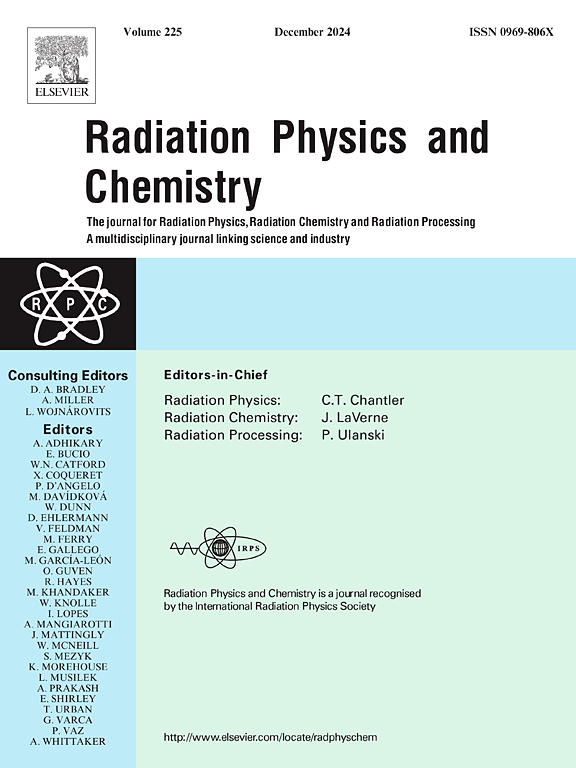摩洛哥一家医院儿科数字放射摄影的辐射剂量和癌症风险评估
IF 2.8
3区 物理与天体物理
Q3 CHEMISTRY, PHYSICAL
引用次数: 0
摘要
本研究旨在使用光激发发光剂量计(OSLD)和拟人化模型,调查接受腹部、胸部、骨盆和鼻咽部成像程序的儿科患者的入口表面剂量(ESD)和器官剂量。使用数字射线照相术(DR)对一个 5 岁的 ATOM 儿科模型进行成像,成像条件与常规射线照相术类似(曝光参数 kVp、mAs、SID:源图像受体距离)。结果显示,儿科患者腹部(AP)、胸部(AP)、骨盆(AP)和鼻咽部(LAT)的入口表面剂量分别为 0.17 ± 0.03 mGy、0.10 ± 0.00 mGy、0.46 ± 0.00 mGy 和 0.42 ± 0.02 mGy。腹部、胸部、骨盆和鼻咽检查的器官剂量范围分别为 0.05-0.45 mGy、0.01-0.44 mGy、0.13-1.05 mGy 和 0.084-0.99 mGy。腹部、胸部、骨盆和鼻咽部检查的有效剂量(ED)分别为 0.088 ± 0.021 毫西弗特、0.011 ± 0.004 毫西弗特、0.058 ± 0.007 毫西弗特和 0.044 ± 0.024 毫西弗特。根据国际放射防护委员会的健康风险模型,以每 10 000 人-Sv(5%/西沃特)500 个病例的比率来估算,2022 年进行的四次 X 射线儿科手术将来可能会导致 0.015 例健康风险(0.3 人-Sv × 5%/西沃特)。虽然癌症的发病率和死亡率风险极低,但也不容忽视。本文章由计算机程序翻译,如有差异,请以英文原文为准。
Evaluation of radiation dose and cancer risk for paediatric digital radiography in a Moroccan hospital
Pediatric radiography is the first line of most diagnostic examinations and an effective tool that provides important information about the patient's health status.
This study aims to investigate the Entrance Surface Dose (ESD) and organ doses for pediatric patients undergoing imaging procedures of the abdomen, chest, pelvis, and nasopharynx using Optically Stimulated Luminescence Dosimeters OSLDs and an anthropomorphic phantom.
An ATOM pediatric 5-year-old phantom was imaged using a Digital Radiography (DR) based on similar conditions of routine radiography (exposure parameters kVp, mAs, SID: Source Image receptor Distance). The OSLDs were inserted at the appropriate sites to measure localized doses in the sensitive organs.
The results showed that the entrance surface doses for the pediatric patients were 0.17 ± 0.03 mGy, 0.10 ± 0.00 mGy, 0.46 ± 0.00 mGy, and 0.42 ± 0.02 mGy, respectively, for the abdomen (AP), chest (AP), pelvis (AP), and nasopharynx (LAT). The range of organ doses were 0.05–0.45 mGy, 0.01–0.44 mGy, 0.13–1.05 mGy, and 0.084–0.99 mGy for the abdomen, chest, pelvis, and nasopharynx examination, respectively. Effective doses (ED) were 0.088 ± 0.021 mSv, 0.011 ± 0.004 mSv, 0.058 ± 0.007 mSv, and 0.044 ± 0.024 mSv for the abdomen, chest, pelvis, and nasopharynx examination, respectively.
The likelihood of cancer, as determined by the ICRP health risk model with a rate of 500 cases per 10 000 person-Sv (5% per sievert), estimated that a 0.015 case of health risk (0.3 person-Sv × 5% per sievert) may in the future be attributable to four X-ray pediatric procedures conducted in 2022.
The ESD, ED, and organ dose values are deemed acceptable compared to those reported in the literature. Although the risk of incidence and mortality from cancer during life is minimal, it should not be ignored.
求助全文
通过发布文献求助,成功后即可免费获取论文全文。
去求助
来源期刊

Radiation Physics and Chemistry
化学-核科学技术
CiteScore
5.60
自引率
17.20%
发文量
574
审稿时长
12 weeks
期刊介绍:
Radiation Physics and Chemistry is a multidisciplinary journal that provides a medium for publication of substantial and original papers, reviews, and short communications which focus on research and developments involving ionizing radiation in radiation physics, radiation chemistry and radiation processing.
The journal aims to publish papers with significance to an international audience, containing substantial novelty and scientific impact. The Editors reserve the rights to reject, with or without external review, papers that do not meet these criteria. This could include papers that are very similar to previous publications, only with changed target substrates, employed materials, analyzed sites and experimental methods, report results without presenting new insights and/or hypothesis testing, or do not focus on the radiation effects.
 求助内容:
求助内容: 应助结果提醒方式:
应助结果提醒方式:


